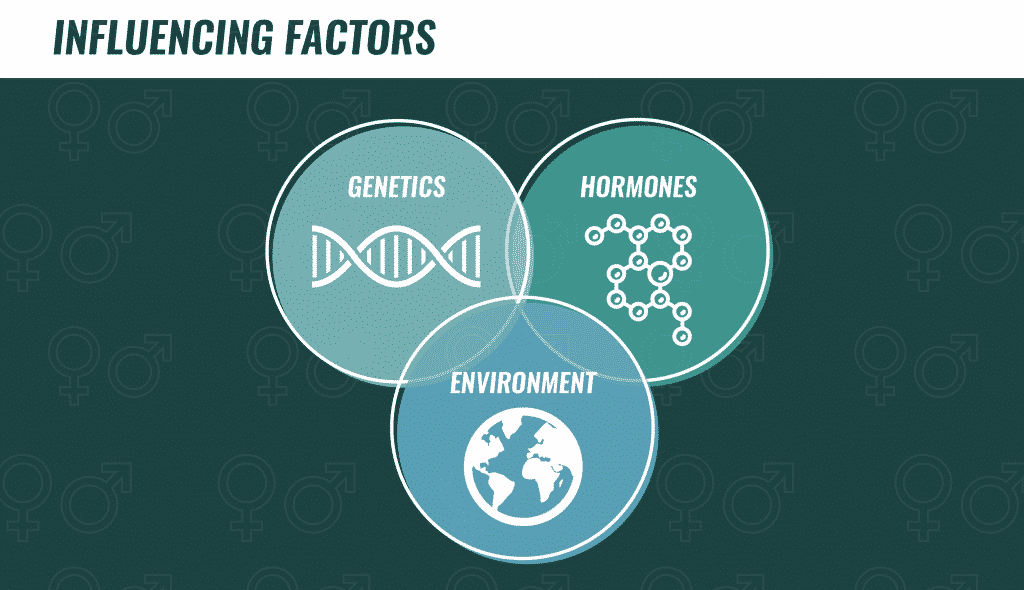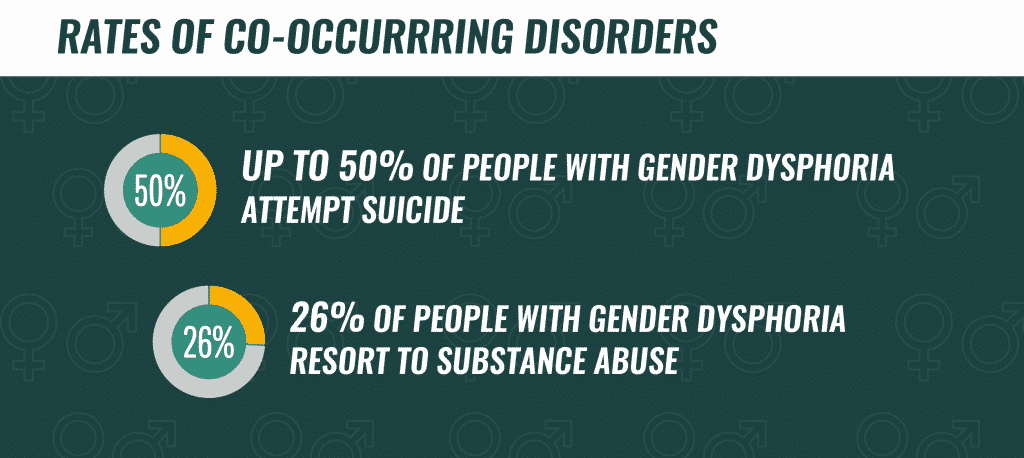Gender dysphoria is gaining greater understanding in our culture. Explore information about the condition, statistics, and demographics.
Gender dysphoria has been a topic of increasing awareness in recent years. This awareness is good news for transgender and gender dysphoric people, who have long been misunderstood and mistreated. Statistics can aid in this increased awareness by revealing more about the prevalence of gender dysphoria, as well as the factors that may contribute to its development.
Prevalence of Gender Dysphoria
Various studies have been conducted around the world to determine the prevalence of gender dysphoria. A Dutch study indicated that 4.6% of 8064 study participants who were born male and 3.2% who were born female-identified themselves as ambivalent to their specific birth gender and were equally able to identify as male or female according to their internal perception of self. According to the Diagnostic and Statistical Manual of Mental Disorders, Fifth Edition, gender dysphoria prevalence accounts for 0.005–0.014% of the population for biological males and 0.002–0.003% for biological females. In both Japan and Poland, the prevalence of gender dysphoria is higher in biological females.
Another important factor to consider regarding the prevalence of transgender people is the sociological risks associated with disclosure. The fear of repercussion may prevent many gender dysphoric people from disclosing their status, which may mean that the prevalence of people with gender dysphoria is higher than currently reported.
Age and Gender Identity
The gender dysphoria age of onset can vary. Children who later develop gender dysphoria may display gender crossing behaviors between the age of 2–4 years. Others may not experience gender dysphoria until puberty. Generally, people with gender dysphoria that carries into adulthood recognize that they have a discrepancy between their biological gender and gender identity at an early age.
Gender identity and recognition typically begin between the ages of 2–4 years. Given this developmental norm, it makes sense that the recognition of one’s internal gender differences would occur during early childhood. In some cases, young children experience gender dysphoria for a short period as part of their development.
Rapid Onset Gender Dysphoria
In some situations, gender dysphoria can emerge rapidly during the puberty phase of development. Rapid onset gender dysphoria has been studied as a phenomenon in which adolescents develop the condition over a short period in conjunction with one or more peers. However, the phenomenon is not clinically validated and requires a significant amount of additional research.
Factors Influencing Dysphoria Development
Gender dysphoria, like any other condition, may have some contributing factors that influence its development. While an exact cause has not been discovered, there is a consensus among researchers that the following factors influence gender dysphoria development:
- Genetic influences
- Hormonal factors
- Environmental features
Cultural changes in understanding and acceptance of gender identity have allowed recent generations to be more open about gender dysphoria. As acceptance of transgender individuals increases, younger generations feel more able to express aspects of themselves that prior generations felt compelled to hide, including gender dysphoria.

Gender Dysphoria and Co-Occurring Conditions
In some cases, gender dysphoria co-occurs with other mental health conditions. Some studies have found that autism and gender dysphoria frequently co-occur in children and adolescents. However, there was little evidence of increased rates of autism among adults with gender dysphoria. Researchers recommend that the task of gender identity and development be considered when looking at autism spectrum disorder to avoid misdiagnosis.
Trauma and gender dysphoria may also be correlated. One study found that 56% of participants who experienced gender dysphoria had also experienced at least four different traumatic events. Approximately 46% displayed signs of disorganized attachment.
Gender dysphoria and depressive disorders can also co-occur. Half of those diagnosed with gender dysphoria also have a co-occurring diagnosis of depression or anxiety. The co-occurrence of these disorders for transgender people is not surprising, given the abusive treatment many receive as a result of their dysphoria. With increased education and discussion, it is hopeful that ignorance surrounding gender dysphoria and transgender individuals will continue to decline.

Rates of Gender Dysphoria and Suicide
People with gender dysphoria have a higher rate of suicide than the general population. A staggering 32–50% of people with gender dysphoria attempt suicide. The rate of suicide attempts is thought to be so high as a result of social stigma, rejection, discrimination, bullying, and violence.
Because of this high suicide rate, it is crucial for people with gender dysphoria to talk about their experiences with trusted loved ones and professionals. It is also vital that support networks and outreach programs provide access to the necessary services to support transgender individuals. There are suicide hotlines specifically for transgender and others in the LGBTQ+ community staffed with compassionate, understanding people who want to help.
Gender Dysphoria and Substance Abuse
An estimated 26.3% of gender dysphoric people resort to substance abuse as a means of coping with diagnosis-related stress and oppression. The researchers concluded that the rate of substance use is thought to stem from three minority-theory experiences: enacted, internalized and social stigma. Living with maltreatment increases the odds of substance abuse, particularly when dealing with a condition that is not as socially accepted or understood as it should be.
Occurrence of Sexual Reassignment Surgery
While some people with gender dysphoria don’t undergo gender reassignment surgery, approximately 25–30% decide to surgically transition. The procedures undergone vary from person to person depending on the specific physical features that trigger their dysphoria.
Gender Dysphoria Treatment and Prognosis
People dealing with gender dysphoria no longer need to live in silence and isolation. Support groups, individual therapy, and peer support are available. Gender dysphoria treatment can consist of a variety of modalities. Some people may decide that they need a place to talk about their thoughts, feelings and the impact of gender dysphoria. Others may seek a plan for hormonal therapy, lifestyle changes, and sexual reassignment surgery. With more treatment options available today than ever before, transgender people can live more openly and with increased supports.


Bouman, Walter Pierre, et al. “Gender Dysphoria and Gender Incongruence[…]rdisciplinary field.” tandonline.com. 2016. Accessed April 13, 2019.
Psychiatry.org. “Diagnostic and Statistical Manual of Mental Disorders, Fifth Edition.”
2013. Accessed April 13, 2019.
Psychiatry.org. “What is Gender Dysphoria?” Accessed April 13, 2019.
Littman, L. “Rapid Onset of Gender Dysphoria in Adolescents and Young Adults: a Descriptive Study.” Journal of Adolescent Health. February 2017. Accessed April 13, 2019.
Glidden, D., Bouman, W.P., Jones, B., Arcelus, J. “Gender Dysphoria and Autism Spectrum […]w of the Literature.” January 2016. Accessed April 13, 2019.
Van Schalkwyk, G.I., Klingensmith, K., Volkmar, F.R., “Gender Identity and Autism Spectrum Disorders.” The Journal of Biology and Medicine: YJBM. March 2015. Accessed April 13, 2019.
Giovanardi, Guido et al. “Attachment Patterns and Complex Trauma i[…]th Gender Dysphoria.” February 2, 2018. Frontiers in psychology vol. 9. Accessed April 13, 2019.
Virupaksha, H.G., Muralidhar, D., Ramakrishna, J. “Suicide and Suicidal Behaviors Among Transgender Persons.” November-December 2016. Accessed April 13, 2019.
Gonzalez, Cesar, et al. “An examination of demographic characteri[…]n the United States.” August 1, 2108. NCBI.nml.nih.gov. Accessed April 13, 2019.
Bernstein, Lenny. “Here’s how sex reassignment surgery works.” washingtonpost.com. February 9, 2015. Accessed April 13, 2019.
Olinger, K. “Gender dysphoria, what is it?” Transgenderheath.com. March 14, 2018. Accessed April 13, 2019.
Pflag.org. “Support Hotlines.” Accessed April 13, 2019.
The Recovery Village aims to improve the quality of life for people struggling with substance use or mental health disorder with fact-based content about the nature of behavioral health conditions, treatment options and their related outcomes. We publish material that is researched, cited, edited and reviewed by licensed medical professionals. The information we provide is not intended to be a substitute for professional medical advice, diagnosis or treatment. It should not be used in place of the advice of your physician or other qualified healthcare providers.